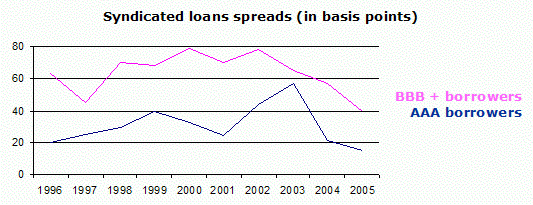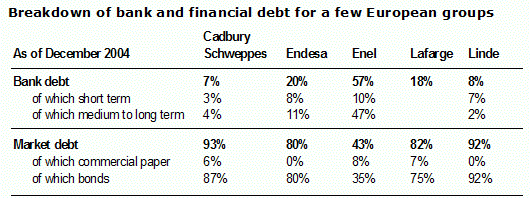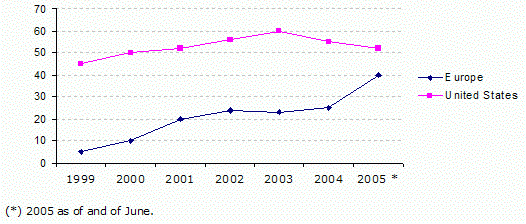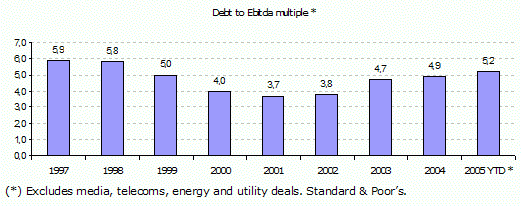Letter number 10 of October 2005
- TOPIC
- STATISTICS
- RESEARCH
- QUESTIONS & COMMENTS
News : The changing loans market, or have the banks gone quite mad?
The syndicated loans arranged recently include some very attractive features for borrowers (1). The improvement can be seen in the spreads (2), as illustrated by the graph below, and also in the type of covenants placed on the company over the loan period and on the length of the loan period itself.
The recent Adidas operation is a good example. The group has cancelled its €800m February 2005 syndicated loan and has arranged a new 5 + 2 year syndicated loan, allowing it to borrow up to €2bn, only paying between 17.5 basis points above the Euribor (3). This spread is exactly the same as in February (0.175%) but the amount raised is 2.5 bigger (€2bn versus €800m). Has the financial structure of Adidas improved in the meantime? Not really as it is in the process of buying Reebok for $3.1bn and of disposing of Salomon for €485m.
Clearly, with this sort of spread, it's hard for banks to make a profit on these loans. Banks are not necessarily able to get refinancing at the Euribor rate. Although some are lucky enough to have access to free resources (for example, French retail banks collect deposits on which most of them do not pay interest), most international banks have to get refinancing on the interbank market, and pay an interest rate that is significantly higher than the Euribor rate (the banks’ spreads go from a few basis points to more than 20 for some of the US investment banks).
Additionally, corporate loans are weighted risks, with banks having to use equity capital in order to guarantee their solvency margin. Take the example of a bank refinancing at Euribor + 10 basis points, which grants a loan of €100m to a company at Euribor + 30 basis points (which is in line with current market rates for US corporations). If it wants to hold onto its Tier 1 capital ratio of 6%, which is the minimum, it has to freeze €6m of its equity capital for this loan. The return on the loan will be 0.20% x 100 = €0.2m. A return of 0.2/6 =3.3% before tax! This back-of-the-envelope calculation does not of course include additional fees that the bank would get (arrangement fee, participation fee) but we have also not factored in the cost of arranging the loan.
Implementation of the new prudential ratios that have come out of Basle II (4) will of course mean that the amount of equity capital allocated to a loan will be in line with the risk, and that this amount will be reduced for the most creditworthy borrowers. As things stand today, banks are required to set aside the same amount of equity capital when lending to Fiat as when lending to Nestlé.
And it’s not just low spreads. Legal provisions have also become a lot more advantageous for companies:
- Covenants. Banks are including fewer and fewer financial covenants in their loan packages (covenants are financial ratios that the company undertakes to meet, or the loan becomes payable immediately (5)). Some credit lines are granted without any covenants at all.
- Indexing spreads to financial rating. This was until recently a very frequent practice for companies with Tier 1 financial rating.
- The spread compared with the rating grid. The very competitive situation on the market at the moment means that lending banks do not always avail themselves of this protection.
- MAC clause (6). This clause provides for the repayment of the loan in the event of the occurrence of a major event which impacts negatively on the bank. Many banks failed to include a MAC clause in a large number of the syndicated loan agreements arranged this year.
The average duration of loans has also increased substantially, with companies locking banks into favourable terms over relatively long periods.
Mediocre returns, little protection in the event of the company's risk deteriorating, extended maturity dates, have the banks gone quite mad? What sort of explanations can be offered?
Atrophied loans portfolio
After the Internet bubble burst, banks started to worry that more and more companies would be filing for bankruptcy, and as a result, they tightened up their lending policies. One of the things they did was to be far more selective when determining which companies would be eligible for a loan. Fear of a credit crunch thus resulted in banks drastically reducing the amount of their weighted risks.
Now that this fear is no longer there, the banks have surplus equity capital compared with their existing portfolios. The amount of surplus equity capital has been estimated at €45bn, for European listed banks only, which explains the recent spate of large share buybacks. It also explains a desire to beef up the loans portfolio. But the 46% increase for syndicated loans in Europe over the first 9 months of 2005 is misleading as its mainly due to renegociation of existing facilities which are cancelled only to be replaced by new ones with more favorable terms for borrowers.
Reduction in the level of corporate borrowing
At the same time, in a depressed economic climate, companies cut back heavily on their borrowing, (no more acquisitions, disposal of non-strategic assets, capital increases in order to balance financial structures and to fix mistakes made in the past). So it was shareholders who found that they had taken the place of the banks which had become reluctant to lend companies money.
Additionally, large groups continued to increase their market debt (issuing bonds or commercial paper) which now accounts for over 50% of the debts of many of the large corporates.
Reduced perception of risk
In Europe, the problems faced by large corporates did not turn into bankruptcies accompanied by knock-on effects (7), and these groups succeeded in putting rescue plans in place (sometimes with the help of the state). So, whether it was Alstom, Ahold, Vivendi Universal, Karstadt Quelle, or Alitalia, the banks did not suffer major losses. Incidentally, no banks went bankrupt either, which would have reduced the size of the loans offer.
Search for steady income stream
During the period between 2001-2004, universal banks saw (again) how revenues from investment banking are extremely cyclical. Lending activities do bring lower returns, but the revenue stream is steadier (which means less risky). So we saw how Merrill Lynch, after having provided 33% of the Aventis €16bn acquisition loan, appeared keen to keep hundreds of millions of euros on its books.
Forging long-term relationships with the company in the aim of winning more lucrative deals
Most companies develop long-term relationships with a small number of banks. These are often referred to as relationship banks. The group will naturally call on these banks for a number of operations, especially for issuing securities on the market (shares, convertible bonds, bonds). These operations are generally more lucrative for banks and help set off the low returns they get on loans. In such cases, banks often consider their loans business as a sort of loss leader.
In short, the loans market is a real market with an offer and demand, and when demand falls, prices (spreads) go the same way.
What could bring an end to this very favourable situation for companies? A strong recovery in spending by groups especially in M&A deals, M&A activity in the banking sector reducing the offer for loans or a collapse of the corporate bond market. The flurry of M&A deals in recent months (Gas Natural bid on Endesa, Allianz and Suez buying up their minority interests, …) might be a sign that the credit cycle has started to turn. However, markets are volatile, and it pays to expect the unexpected.
A word to the wise is enough!
(2) The spread is the portion of the interest allocated to the risk of the company defaulting. It is also the difference between the interest rate and the risk-free rate (government bond rate for long-term rates, Euribor, Libor or swap rates for short-term rates).
(3) I.e. if the 3-month Euribor is 2%, Salomon can borrow at 2.175%.
(4) For more details see Vernimmen.com Newsletter n°9.
(5) For more information, see chapter 27 of the Vernimmen.
(6) Material Adverse Change.
(7) with the exception of Parmalat.
Statistics : Some statistics about the debt market
When in the mid 1990s Eurotunnel started its first round of negociations to restructure its financial structure, it faced large banks such as Barclays, HSBC, BNP or Crédit Agricole.
Nowdays, the story is completely different as most banks have sold their Eurotunnel loans to financial investors, mostly hedge funds. This trend is not limited to bad credit situations as illustrated by the following graph, it is already the rule in the United States when institutional investors end up buying one half of loans granted by banks:
2. Average leverage multiples for LBOs with Ebitda of US$50m+, 1997 - 2005
End of August 2005, LBO volumes were at $110bn compared to $93bn for the whole 2004 year and only $47bn in 2003.
Private equity sponsors have large pools of money to put to work and banks are eager to lend (see previous article). The result is that the average debt, to Ebitda ratio could be, end of 2005, close to its 9 years record (5.9 in 1997).
SunGard cleared the market in July at 7 x and Neiman Marcus at 6.5. last week.
Research : Shareholder investment horizon
This is not the first time that such criticism has been voiced. As early as the 1980s, researchers in the field of finance had already expressed their concerns on the issue. These days, given the recent events, hedge funds, with their often very short investment horizon, come to mind.
In practical terms, what has happened to this link between the investment horizon of the shareholders in a firm, and the same firm’s investment policy? This is not an easy question to answer, but three researchers have tried to shed some light on the matter by studying the impact of shareholder investment horizons on mergers and acquisitions of US corporations (1).
From a theoretical point of view, there are two distinct ways in which institutional shareholder investor horizons should influence the actions of management:
- Firstly, institutional shareholders with long-term investment horizons will monitor management more closely. The advantages to be gained from holding onto a company’s shares over a longer period will encourage them to exert greater control over managers’ choices. Managers are thus likely to see their discretionary powers curbed by an investor with a long-term horizon, and agency problems (2) are likely to be reduced. Accordingly, managers should be less inclined to try and gain personal benefits from their positions and are unlikely to make value-destroying acquisitions for the purpose of building an empire.
- Secondly, shareholders with a long-term investment horizon have greater bargaining power. They are thus able to secure a larger share of the economic surplus created by the bidder when the deal is negotiated. Unless they are offered a high price, such shareholders have no interest in tendering their shares. They could just as easily hold onto their shares in the hope that, in the long-term, the share price will improve as a result of the acquisition.
The team of researchers looked at US data between 1980 and 1999. Institutional shareholders were classified in terms of their investment horizons on the basis of their portfolio churn rates. Institutional investors that rotate a large percentage of their portfolios over time were classified as having a short-term investment horizon. Those that hold onto their portfolios were classified as long-term investors. The researchers then determined how firms behave during M&As, whether as bidders or targets, on the basis of the dominant shareholder type.
Their results confirm the theoretical assumptions presented above:
- Target firms with short-term institutional investors have a lower acquisition premium than firms with a long-horizon ownership structure. This is consistent with the two interpretations above. Short-term investors have less bargaining power over the bidder than long-term shareholders. Additionally, managers of target firms are less closely monitored by short-term shareholders. Accordingly, they have more freedom in their negotiations with the company bidding for their firm. It may not necessarily be in their best personal interests to negotiate a large acquisition premium for their shareholders, as they may prefer to focus on large personal benefits for themselves (e.g. golden parachutes or a top job at the new entity created or at the bidder firm). This is why these firms get relatively lower acquisition premiums.
- Bidder firms with short-term shareholders also have a more negative abnormal return than those with long-term shareholders. They would appear to embark on M&A deals that are perceived by the financial markets as value-destroying. This observation is consistent with the assumption of less control over managers’ decisions by short-term shareholders, which once again gives them more room for manoeuvre, and investment decisions that may run contrary to the interests of shareholders.
- Short-term shareholders increase the probability of an M&A bid being made. Firms with short-term shareholders are more likely to bid for other firms and are also more likely to be the target of a bid.
- Firms with short-term investors that make an acquisition tend to under perform over the long term to a greater extent than firms with long-horizon ownership structures. Once again, this observation is consistent with the assumption that short-term investors exercise less strict control over their managers, and that the latter take decisions that are not in the shareholders’ best interests. Long-term shareholders monitor managers more closely, which is beneficial for all of the shareholders.
Ownership structure would appear to play a major role in M&A deals. A long-horizon ownership structure serves to discipline the managers of the target firm during negotiations for the sale, and also the managers of bidder firms in their choice of targets. In both cases, shareholders with a long-term investment horizon appear to create shareholder value in the context of M&A deals.
If we are prepared to accept that these findings in the restrictive environemnt of M&As could also apply on a wider scale, then we can understand why financiers place such importance on the choice of a firm’s ownership structure at the time of its IPO (3). A long-horizon ownership structure creates conditions that will encourage an increase in enterprise value and limit agency problems.
(2) For more on agency theory, see chapter 32 of the Vernimmen 2005.
(3) For more information, see chapter 31 of the Vernimmen.
Q&A : How does one go about choosing between dividends, share buybacks and capital reductions?
There are five key criteria used by financial managers to decide which instrument would be best suited to achieving the desired result:
1. Flexibility
Any large, sudden change in the size of the dividend paid is always tricky. It raises questions about the company’s business model and creates shareholder expectations that they’ll be getting the same sort of dividend on a recurring basis. Accordingly, increasing the size of ordinary dividend payments is usually a slow process and only impacts on the company’s capital structure after several years.
Capital reductions and extraordinary dividends are, however, one-off operations, that do not raise shareholder expectations of recurrence. They are thus very well suited to returning the proceeds of the disposal of a large asset to investors (e.g. the Enel distribution network in 2004) or to modifying the company's capital structure (Bouygues in 2005).
2. Signalling
As all financial decisions may be taken as a signal by the investor, the company should think carefully about how the market will perceive the instrument chosen for returning funds to shareholders.
The extraordinary dividend sends out the most neutral signal. By definition, extraordinary dividends are one-off rather than recurrent, and accordingly carry no implicit judgement of the value of company’s share, of which they are independent. Finally, all shareholders benefit from exceptional dividends.
On the other hand, a change in the size of the dividend or a capital reduction are received by the market as clear signals. In the first case, positive expectations are created about future profits. A company that reduces its capital is sending out a signal about the value of its shares, as no company would buy back its shares if management believed that the company was currently overvalued.
3. Impact on the shareholder base
The dividend and the exceptional dividend have no impact on the shareholder base as they do not alter the number of shares in the company. A capital reduction and share buybacks will, however, quite naturally impact on the composition of the shareholder base, since some shareholders may well decide against participating in the capital reduction or selling their shares on the market during the period when the company is in the process of buying back shares. Their share in the capital will increase. Starting in 1999, the Peugeot family steadily increased its stake in the Peugeot group from 22.7% to 29.2%, by spending €2,580m buying up shares on the market. Increasing the size of the ordinary dividend, which would be difficult in a sector that is as cyclical as the automotive sector, or paying an exceptional dividend, would obviously not modify the shareholder base.
4. The impact of management stock options
If shares are bought at a price which exceeds their market value during a capital reduction, there are often statutory provisions for adjusting the exercise price of stock options which renders the operation neutral for the holders of stock options.
However, most laws make no such provisions in the case of payments of dividends or exceptional dividends and share buybacks on the market. As exceptional dividends may drastically reduce the value of the share, the fact that the exercise price of stock options is not automatically adjusted explains why managers are not all that keen on them.
A partial explanation for the strong decline since 2000 in the number of US companies paying a dividend (from 66% in 1978, to 21% in 1999) is the replacement of dividends with share buybacks, probably encouraged by stock option-holding managers (1). Paying a dividend results in the automatic reduction of the share price by the amount of the dividend and thus reduces the expected gain on stock options by as much, as their exercise price remains fixed. Share buybacks do not impact negatively on the value of stock options in this way, and there are even those naïve enough to believe that they could drive the share price up (since shares are being bought!). Some stock option holding-managers sometimes lose sight of the fact that shareholders may need cash, and if they never get a dividend, they may have to sell their shares in order to get hold of it.
5. Tax
The tax issue should obviously not be overlooked as the tax impact may differ, depending on the method used to return funds to shareholders.
When dividends are more heavily taxed than capital gains, companies have a strong incentive to give back cash to their shareholders through share buy-backs than dividends.
In the USA, the tax rate on dividends for individual taxpayers was reduced considerably in 2003, from the marginal income tax rate to 15%. This has resulted in dividends becoming a lot more attractive again. They are now more popular than share buybacks, which in 1999 and 2000 exceeded dividend payments for the first time.
